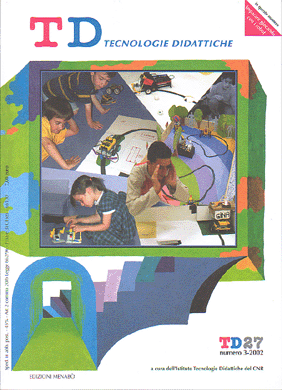Ambienti di gioco programmabili: cos'è possibile per un bambino di quattro anni?
Contenuto principale dell'articolo
Abstract
Dettagli dell'articolo
Gli autori che pubblicano su questa rivista accettano le seguenti condizioni:
- Gli autori mantengono i diritti sulla loro opera e cedono alla rivista il diritto di prima pubblicazione dell'opera, contemporaneamente licenziata sotto una Licenza Creative Commons CC BY 4.0 Attribution 4.0 International License.
- Gli autori possono aderire ad altri accordi di licenza non esclusiva per la distribuzione della versione dell'opera pubblicata (es. depositarla in un archivio istituzionale o pubblicarla in una monografia), a patto di indicare che la prima pubblicazione è avvenuta su questa rivista.
- Gli autori possono diffondere la loro opera online (es. in repository istituzionali o nel loro sito web) prima e durante il processo di submission, poiché può portare a scambi produttivi e aumentare le citazioni dell'opera pubblicata (Vedi The effect of Open Access).
Riferimenti bibliografici
Ackermann E. (1991), The “Agency” Model of Transactions: Toward an Understanding of Children’s Theory of Control, in Harel I. & Papert S. (eds), Constructionism, Ablex Publisher, Norwood, NJ.
Ackermann E. (2000), Relating to things that think: Animated toys, artificial creatures, avatars, I3 Magazine: The European Network for Intelligent Information Interfaces, n. 8, July, pp. 2-5.
Ackermann E., Archinto F. (2001), Giochi linguistici, scrittura digitale, alfabetizzazioni emergenti, TD – Tecnologie Didattiche, n. 24, pp. 41-54.
Ackermann E., Strohecker C. (1999), Build, Launch, Convene: Sketches for Constructive-Dialogic Learning Environments, MERL Technical Report, TR99-30.
Ananny M. (2001), Telling Tales: Supporting written literacy with computational toys, Unpublished Master Thesis, The MIT Media Laboratory, Cambridge, MA.
Barchi P., Cagliari P., Giacopini E. (2001), Encounters between children and robotics, in Askildsen T., Barchi P., Cagliari P., Chioccariello A., Giacopini E., Gustafsson B., Lindh J., Manca S., Rausch M., Sarti L., Construction kits made of Atoms and Bits. Research findings & perspectives, CAB Del. 25, http://cab.itd.ge.cnr.it/p ublic/deliverables/booklet/ booklet-CRE.pdf
Brandes A. (1996), Elementary School Children’s Images of Science, in Kafai Y. B., Resnick M. (eds), Constructionism in Practice: Designing, Learning and Thinking in a Digital World, Lawrence Erlbaum Associates, Hillsdale, NJ.
Cassell J., Ryokai K. (2001), Making Space for Voice: Technologies to Support Children’s Fantasy and Storytelling, Personal Technologies, 5(3), pp. 203-224.
Chioccariello A., Manca S., Sarti L. (2002), La fabbrica dei robot, TD Tecnologie Didattiche, n. 27, pp. 56--67.
Granott N. (1991), Puzzled Minds and Weird Creatures: Phases in the Spontaneous Process of Knowledge Construction, in Harel I. & Papert S. (eds), Constructionism, Ablex Publisher, Norwood, NJ, pp. 295-311.
Maeda J. (2000), Design by numbers, The MIT Press, Cambridge, MA.
Martin F. G. (1988), Children, cybernetics, and programmable turtles, Unpublished Master’s thesis, Department of Mechanical Engineering, MIT, Cambridge, MA.
Papert S. (1980), Mindstorms: Children, Computers, and Powerful Ideas, Basic Books, New York.
Papert S. (1993), The Children’s Machine: Rethinking School in the Age of the Computer, Basic Books, New York.
Resnick M., Berg R., Eisenberg M. (2000), Beyond Black Boxes: Bringing Transparency and Aesthetics Back to Scientific Investigation, Journal of the Learning Sciences, vol. 9, n. 1, pp. 7-30 (tr. it. in questo numero).
Turkle S. (1984), The Second Self: Computers and the Human Spirit, Simon and Schuster, New York. Turkle S. (1995), Life on the Screen: Identity in the Age of the Internet, Simon and Schuster, New York.

